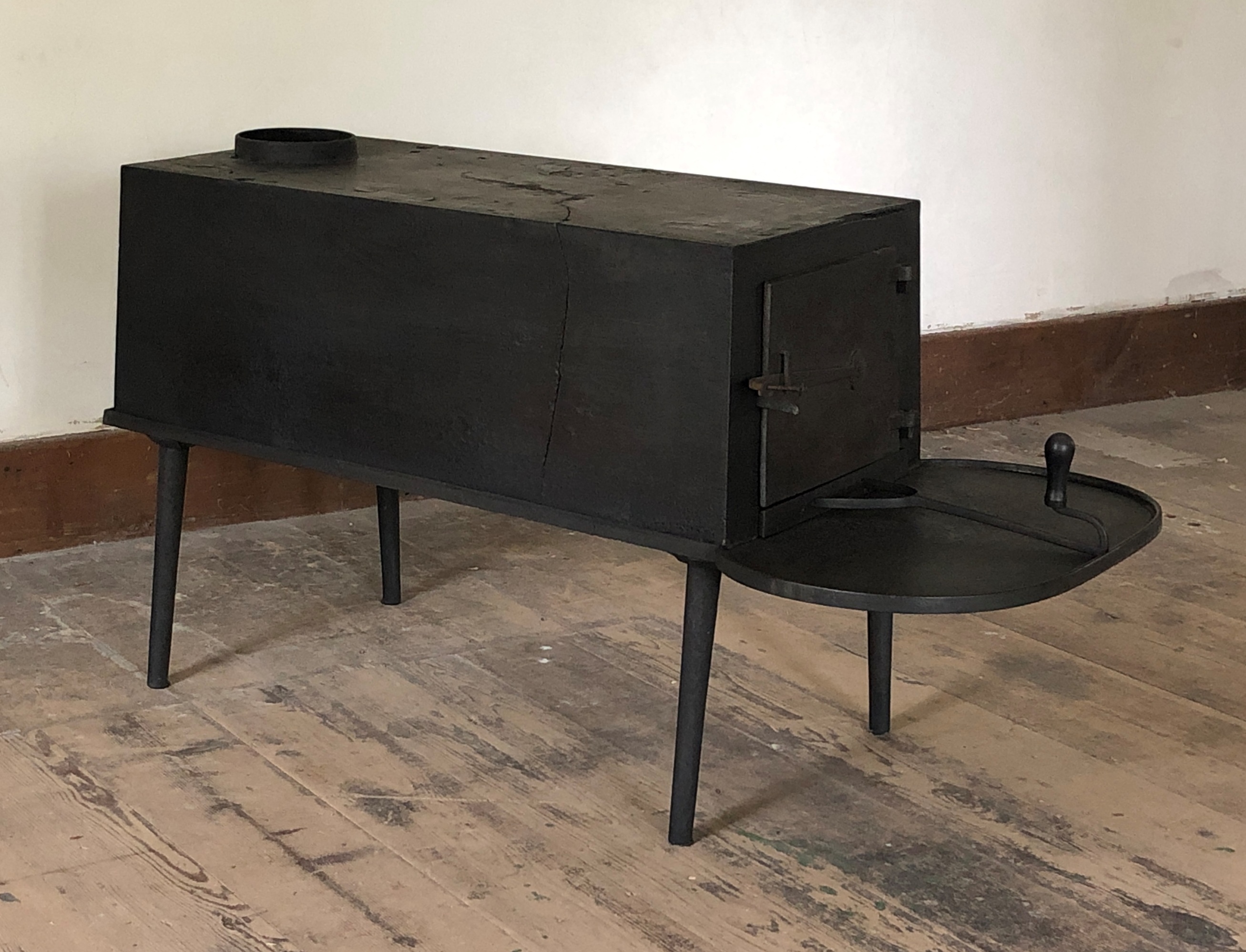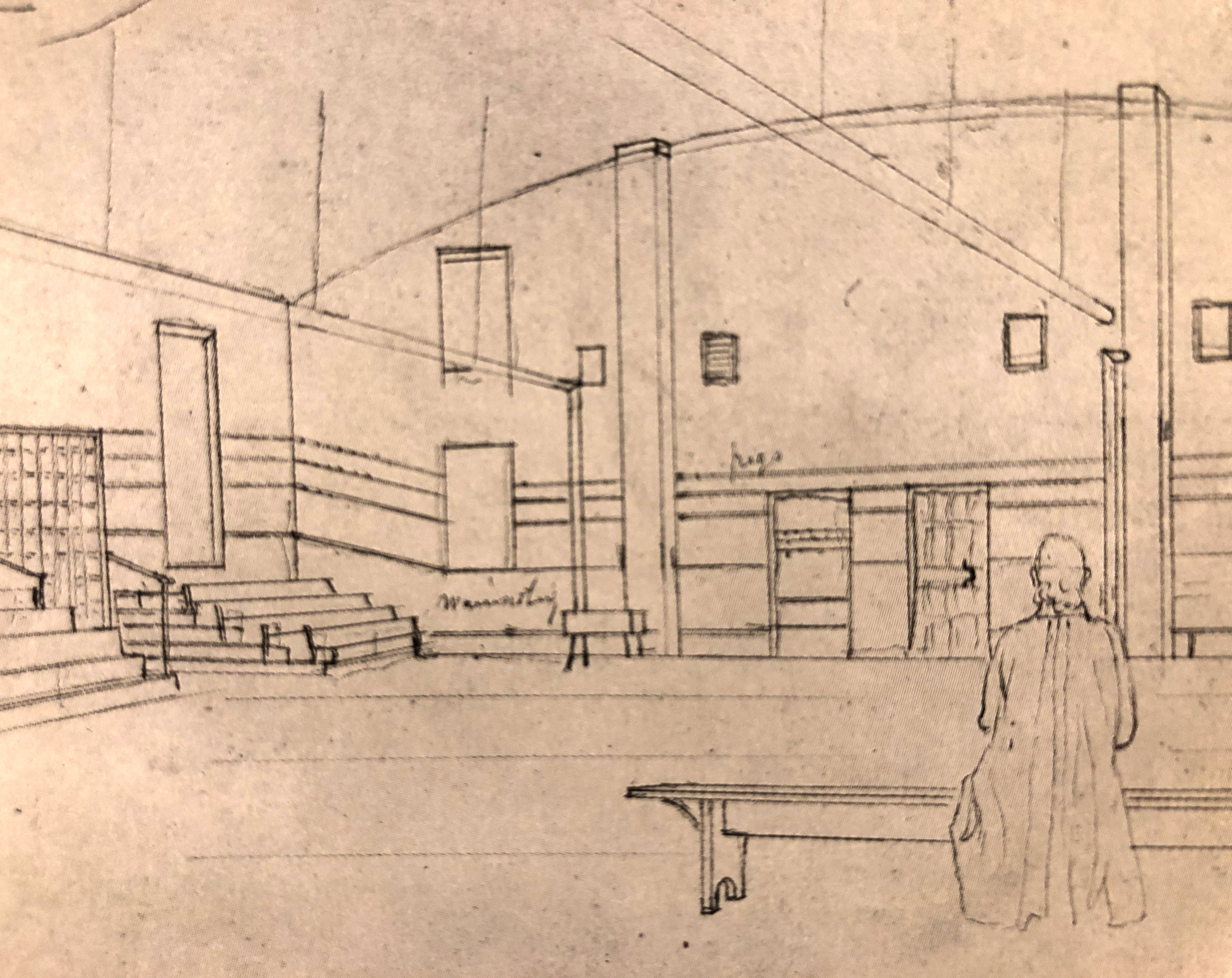
Wood Stove (front view), Church Family, Mount Lebanon, NY, 1824-1840. Shaker Museum: 1950.1121.1a,b,c,d. Staff photograph.
The Shakers’ worship services were such a popular draw for the public in the 1820s that the Mount Lebanon Shakers began to plan for a larger meetinghouse in December, 1821. It took nearly two and a half years to get the building ready for its dedication on June 4, 1824. It was a challenging project – both […]
The Shakers’ worship services were such a popular draw for the public in the 1820s that the Mount Lebanon Shakers began to plan for a larger meetinghouse in December, 1821. It took nearly two and a half years to get the building ready for its dedication on June 4, 1824. It was a challenging project – both in planning and execution. The new meetinghouse could accommodate several hundred Shakers and over 1,000 visitors. It is a massive building – one of the largest construction projects the Lebanon Shakers had undertaken. The size of the building brought many challenges, including placing a roof over a 65 foot span without the intermediate posts that would have interfered with the dances performed during Shaker worship; supporting a floor that would bear the weight of hundreds of Shakers moving en masse; building a structure tall enough that the windows would provide light all the way to the center of the room so as to avoid using artificial lighting; and, since the Shakers apparently planned to hold meetings in the building all year, heating a space that contained nearly 100,000 cubic feet.

The Second Meetinghouse, Church Family, Mount Lebanon, NY, ca. 1871, Shaker Museum: 1960.12581.1. Print from a glass plate negative by James Irving, negative in the collection of the New York State Museum.
The large wood stove presented here – one of four in Shaker Museum’s collection made from the same casting patterns – is identified as being a “Shaker Wood Stove. For Meeting House.” The stove was acquired by the Museum’s founder John S. Williams, Sr., prior to 1950. It is likely that the meetinghouse designation came from one his Shaker contacts or was removed directly by Williams and his workers from that building.

Wood Stove (three-quarter view), Church Family Mount Lebanon, NY, 1824-1840. Shaker Museum: 1950.1121.1a,b,c,d. Staff photograph.
It is not known how or if the Meetinghouse was heated that first winter following its dedication. Chimneys had been built at each end of the sanctuary during its construction in 1823 – designed to provide venting for four stoves. What type of stoves were used or whether the Shakers chose not to initially heat the building is unknown, but heat or no heat, it appears that the comfort level during the winter was found wanting by some members of the community. On January 5, 1834, Elder Brother Amos Stewart, “came this afternoon to intercede for some way to warm the meeting house. He proposed burning Coal instead of wood, & to have the stove pipes enter the chimneys at the opposite ends of the house. We [the Lebanon Ministry] spoke to the Deacons of the Chh [i. e.,Church Family] about the matter.” Two days later it was decided to put coal stoves in the Meetinghouse. A member of the North Family attending the first meeting following their installation commented, “the new coal stoves in full operation, surely, methinks, there are some provident spirits that are ever seeking to contribute to the comfort of others – Blessings attend them.” However, three years later a meeting was held by the elders and trustees of the Lebanon community to consult concerning what to do in the meetinghouse to warm the room better. On December 13th that year, North Family Elder Richard Bushnell and Brother James Farnham traveled “to Troy after more new Stoves for the meeting house” and following Elder Brother Amos Stewart’s advice, the day after Christmas, 1837, the “Brethren put up the long stove pipe on the East side of the meeting house, the West pipe … put up some time ago.”

Wood Stove (front view), Church Family, Mount Lebanon, NY, 1824-1840. Shaker Museum: 1950.1121.1a,b,c,d. Staff photograph.
With two 70-80 foot long stove pipes hung high above the floor of the Meetinghouse and four stoves burning coal, the house was apparently warm enough through the winter months; however, with the beginning of the Era of Manifestations and the examination of every detail of Shaker life that accompanied that period, a message concerning the stoves from the spirit of Father Joseph Meacham was received and later recorded in the Holy Laws of Zion:
It is our desire, says Father Joseph, if the beloved Ministry and Elders feel union, that the four stoves in the Meeting house may all be removed from that sacred place of worship, this week, as they are not exemplary: therefore they cannot be owned; the Holy Laws of Zion do forbid that any such like superfluities as there are upon them should remain in any place that is used to assemble in for sacred devotion.
And therefore, on July 1, 1840, “The four stoves that have been in the lower part of the meeting house were taken out today to be disposed of somewhere else on account of their superfluity.”
From the removal of the superfluous coal stoves to the present day, few manuscript sources have been unearthed to continue the history of heating the Meetinghouse. Two visitors to the Meetinghouse, however, made drawings of its interior that provide some additional information. Benson John Lossing visited the community in 1856 and Joseph Becker in 1870. Lossing did his series of sketches at Mount Lebanon, guided by a Shaker brother who provided access to many Shaker interior spaces. His sketch of the inside of the Meetinghouse was presumably done as he stood in the space. He later redid the sketch as a watercolor and the sketch and watercolor were then given to William Barritt, who prepared a wood engraving that was printed in the July 1857 issue of Harper’s New Monthly Magazine with the title, “Interior of the Meeting House.” While the printed wood engraving is the common image reproduced and the watercolor, now in the collection of the Winterthur Museum, Garden & Library, is the most attractive, Lossing’s original sketch provides the most accurate information about the Meetinghouse interior. Of specific interest is his inclusion of a simple box stove similar in most details to the Meetinghouse stoves in the Museum’s collection and his detail showing the long stove pipes includes the wires or rods from which they were hung from the ceiling – a detail missing in the watercolor and wood engraving. The presence of the box stoves in 1856 suggests they were the stoves that had replaced the fancy coal-burning stoves in 1840. It is possible, however, that the box stoves are the stoves originally used in the Meetinghouse and the Shakers merely recovered them to replace the too-fancy coal-burners.

Detail from Benson John Lossing’s “Interior of the Meeting House,” Church Family, Mount Lebanon, NY, 1856. Reproduced from An Early View of the Shakers: Benson John Lossing and the Harper’s Article of July 1857 edited by Don Gifford, 1989. The original sketch is in the collection of the Huntington Library, San Marino, CA.
In the spring of 1870 Joseph Becker, an illustrator and manager of the art department for Frank Leslie’s Illustrated Newspaper, visited Mount Lebanon and produced a series of sketches that were reproduced as wood engravings and published Leslie’s in 1873. The final drawing to be published, “New York State. The Shakers of New Lebanon. Religious Exercises in the Meeting-House,” depicts dancing in concentric circles of Shaker brothers and sisters. Becker, like Lossing, made his sketch from the north end of the sanctuary looking to the south, and like Lossing he included a stove, in fact two stoves, in relatively the same position as had Lossing. However, by 1870, the box stoves had apparently been replaced with taller cylindrical stoves that were likely a return to coal-burners. Becker shows both stoves with their stove pipes venting directly into the south chimneys, but included what appear to be long stove pipes coming from the north end of the room that do not quite connect to the south chimneys. It seems likely that the wood engraver who worked from Becker’s sketch did not quite understand how the Shakers had piped their stoves or did not understand what Becker’s long lines were supposed to represent at all.

Detail from Joseph Becker’s, “New York State. The Shakers of New Lebanon. Religious Exercises in the Meeting-House,” Frank Leslie’s Illustrated Weekly Newspaper, November 1, 1873, Shaker Museum: Emlen Collection 2021.16.42.
While there is still something to be discovered about the challenges the Shakers faced in heating the nearly 100,000 cubic feet of air in the Meetinghouse, the manuscript record and two artists who paid meticulous attention to detail provide a good idea of the Shakers’ constant attempts to improve this space and the role the four stoves in the Museum’s collection played in that story.
Update: Today (June 17, 2021) looking through financial records in the Western Reserve Historical Society’e Shaker Collection (mss. no. II:A-8) the following excerpts, thought not a definitive answer to the question of when the Shakers began heating the Meetinghouse, does shed some light on possibilities:
From: “Records of work done at the meeting house by 2d Fam. & 2nd Order…Imperfect or incomplete & I question their value of their preservation.”
“Oct 2 stoves @ 9.50 pur & expenses 16/money 21.02
for sheet iron for the stoves 8.44
2 days after the stoves &c 1 man & 2 horses 4.00
Dec. Work David Gennings at the stoves 10 days 5.00”
And from: “Money paid out by the Church for building the Meeting House.”
“Jan. 2d 1824 2 Large Stoves 16.77
Sheet iron for pipes”
It is not clear from these records if the Shakers purchased two or four stoves and whether they were used in the sanctuary or in the ministry’s quarters in the porch of the Meetinghouse.